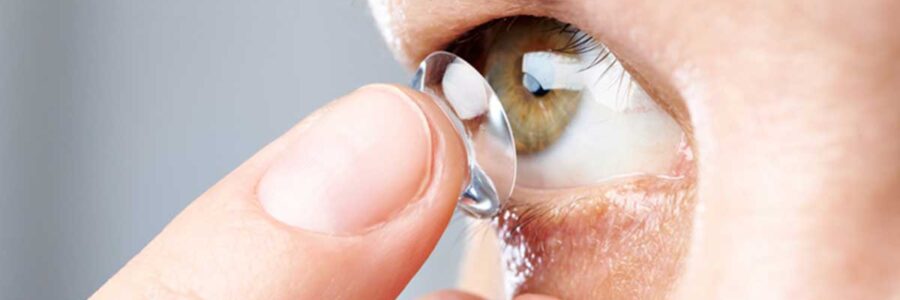A recent study conducted by Mamavation examined the presence of PFAS (per- and polyfluoroalkyl substances) in soft contact lenses, shedding light on potential health risks associated with these popular eye care products.[1] This article presents the findings of the study and discusses the health effects of PFAS exposure through contact lenses.
The Health Effects Linked to PFAS “Forever Chemicals”
PFAS are a class of chemicals known for their resistance to stains, oils, and water. However, they have also been associated with several serious health effects. Research has linked PFAS exposure to:[2-4]
- compromised immune function
- reduced vaccination response
- increased risk of allergies and asthma in children
- developmental issues in infants and children
- elevated cholesterol levels
- metabolic diseases such as obesity and diabetes
- cardiovascular disease
- decreased fertility in both men and women
- increased risk of certain cancers, endocrine disruption, and disrupted thyroid function
Potential Problems with PFAS Exposure Through the Eyeball
While the extent of PFAS leaching into the body through eye exposure is not well-established, studies have shown that dermal exposure to PFAS can occur. Given the sensitivity of the eyes and the evidence of widespread PFAS presence in the general population, it is crucial to minimize PFAS exposure from all sources, including contact lenses.
Although specific studies on PFAS exposure through contact lenses are lacking, precautionary measures should be taken when selecting contact lenses, in consultation with eye care professionals, due to the potential risks associated with PFAS exposure.
Environmental Impact of Improper Contact Lens Disposal
Improper disposal of contact lenses can have adverse effects on the environment. In the United States alone, an estimated 2.5 billion contact lenses, weighing approximately 44,000 pounds, are discarded annually.[5] Unfortunately, many contact lens users dispose of their lenses by flushing them down the toilet or draining them in sinks, leading to their entry into wastewater treatment plants.
Contact lenses’ small size and transparency pose challenges for effective removal during wastewater treatment processes, resulting in an estimated 6 to 10 metric tons of plastic lenses ending up in U.S. wastewater annually.[1, 5]
PFAS in Contact Lenses
Typically, contact lenses consist of poly(methylmethacrylate), silicones, and fluoropolymers. The presence of organic fluorine, a marker for PFAS, in contact lenses suggests the use of fluoropolymers containing PFAS in varying amounts and for different functions, depending on the lens type and brand.[1]
Findings of the Lab Study on PFAS in Contact Lenses
The study analyzed 18 soft contact lenses from three major brands in an EPA-certified laboratory.[1] PFAS indications were detected in all contact lens products tested. The levels of organic fluorine, an indicator of PFAS, ranged from 105 to 20,700 ppm.
Notably, popular brands such as Acuvue, Alcon, and Coopervision exhibited varying levels of PFAS. About 22% of the contact lenses had organic fluorine levels exceeding 18,000 ppm, and 44% had levels exceeding 4,000 ppm.[1]
Expert Commentary and Recommendations
Prominent scientists and experts in environmental health, including Linda S. Birnbaum and Pete Myers, have expressed concerns about the presence of organic fluorine in all tested soft contact lens products.
The lack of safety studies on these products and the potential risks associated with PFAS exposure highlight the need for caution. Terrence Collins, a professor of Green Chemistry, emphasizes considering health, environmental, and fairness performances when evaluating the safety of products containing fluoropolymers.[1]
Summary and Recommendations:
The findings of this study raise concerns about the presence of PFAS “forever chemicals” in soft contact lenses. Consumers should discuss these findings with their eye care professionals when making decisions about their eye care, considering the potential health risks associated with PFAS exposure and the sensitivity of the eyes. While we need further research to fully understand the specific risks of PFAS exposure through contact lenses, it is important to take precautionary measures.
Optometrists and eye care professionals should engage in discussions with patients about the necessity of fluoropolymers in contact lenses and explore alternative chemistries to ensure the safety and well-being of their patients. Proper disposal of contact lenses is also essential to mitigate the environmental impact. Contact lens users should avoid flushing them down the toilet or draining them in sinks and instead dispose of them in designated waste bins.
Researchers and regulators need to conduct further research and regulation to better understand the extent of PFAS presence in contact lenses and its potential impact on human health and the environment. It is crucial to prioritize the development and use of safer alternatives to PFAS in contact lens manufacturing to protect both individuals and the planet.
References:
- “Mamavation’s Lab Finds Indications of PFAS ‘Forever Chemicals’ Inside 100% of Eye Contacts Tested.” Mamavation, 2023, www.mamavation.com/health/pfas-contact-lenses.html.
- Fenton, Suzanne E et al. “Per- and Polyfluoroalkyl Substance Toxicity and Human Health Review: Current State of Knowledge and Strategies for Informing Future Research.” Environmental toxicology and chemistry vol. 40,3 (2021): 606-630. doi:10.1002/etc.4890
- ATSDR Pfas Clinical Guidance – Agency for Toxic Substances and Disease …, www.atsdr.cdc.gov/pfas/docs/clinical-guidance-12-20-2019.pdf.
- “Read ‘Guidance on PFAS Exposure, Testing, and Clinical Follow-up’ at Nap.Edu.” 3 Potential Health Effects of PFAS | Guidance on PFAS Exposure, Testing, and Clinical Follow-Up |The National Academies Press, nap.nationalacademies.org/read/26156/chapter/5.
- Clspectrum.Com www.clspectrum.com/issues/2019/august-2019/the-environmental-impact-of-contact-lens-waste.


